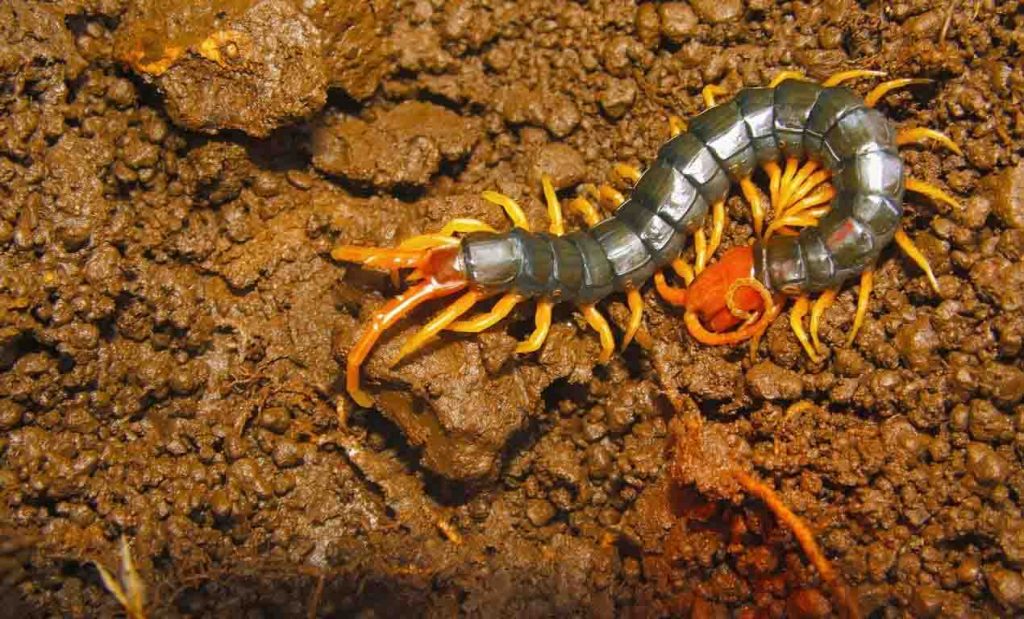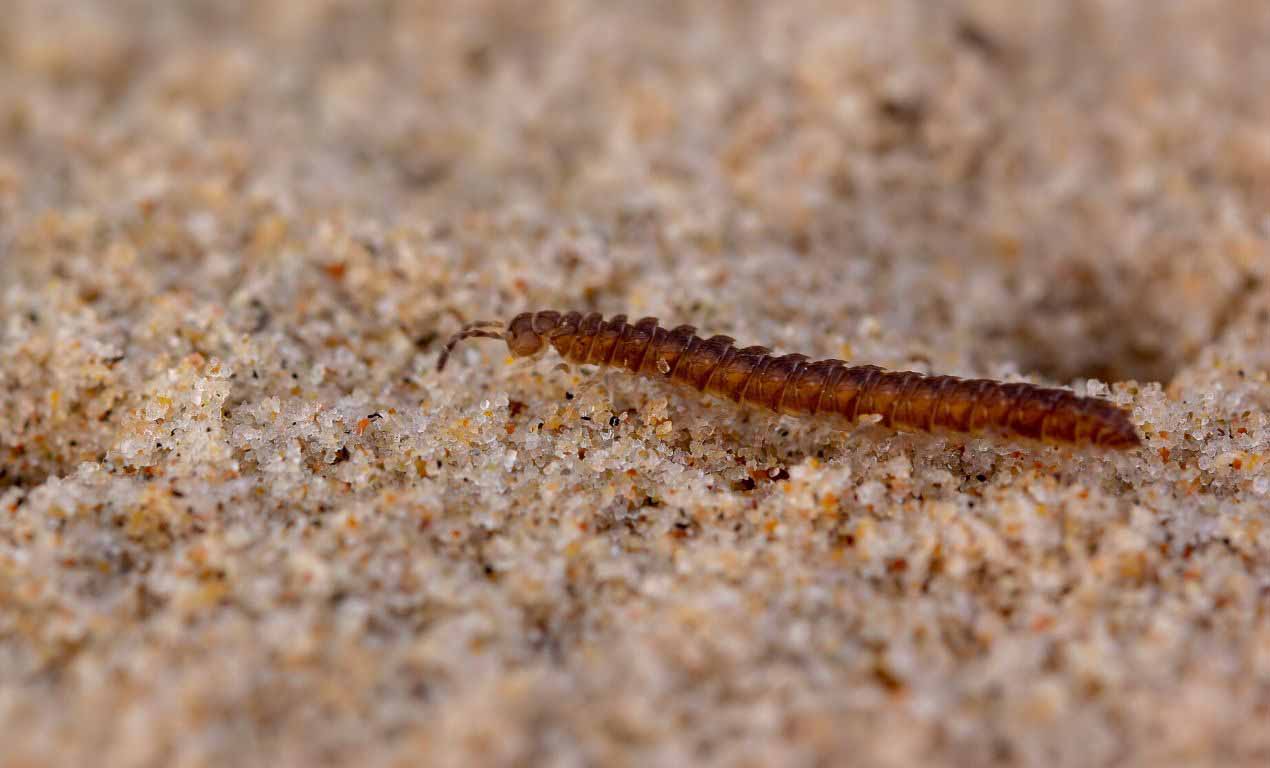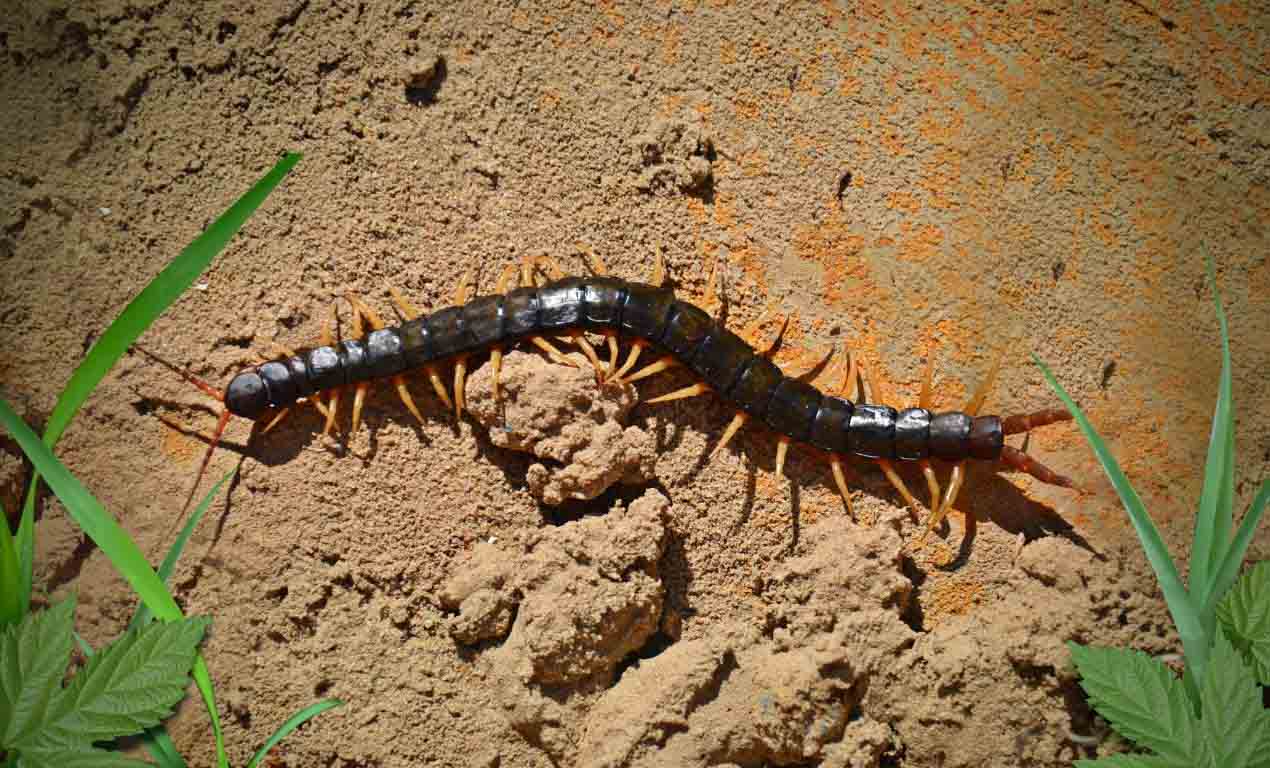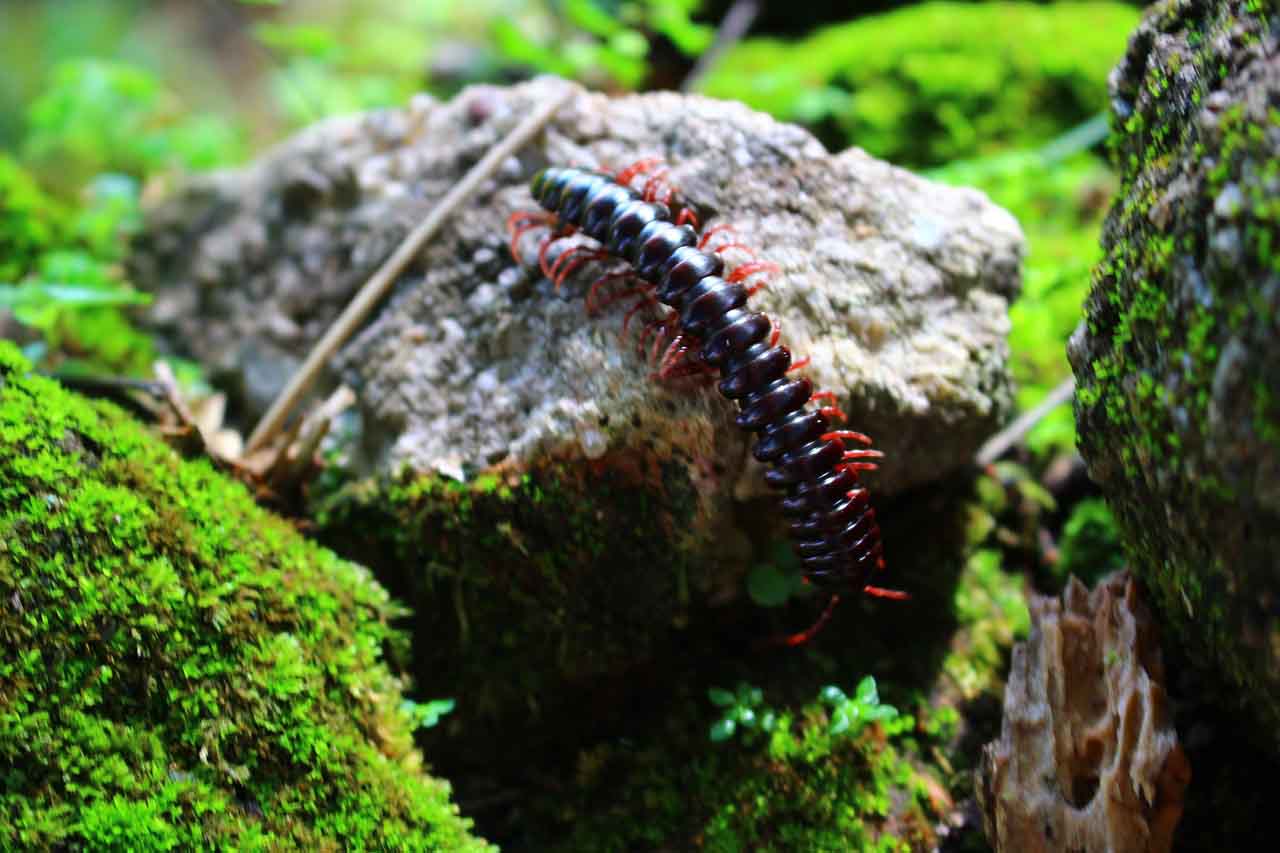
 Centipedes are predatory arthropods and belong to class Chilopoda. They are elongated metameric creatures with one pair of leg per body segment. Most centipedes are venomous, injecting their poison through a pincer-like appendage, called the forcipules. No centipedes have a hundred legs. They always have odd pairs of legs.
Centipedes are predatory arthropods and belong to class Chilopoda. They are elongated metameric creatures with one pair of leg per body segment. Most centipedes are venomous, injecting their poison through a pincer-like appendage, called the forcipules. No centipedes have a hundred legs. They always have odd pairs of legs.
Their size varies between a centimeter to twelve inches in length. There are more than 3,000 recorded species of centipedes in the world. They are carnivores and get found across all continents.
But, which centipede has the worst bite? Amazonian giant centipede is considered to have the worst bite. They are the most poisonous centipede and they are one of the largest centipede found on earth. They devour small centipedes, rats and even bats. Their bite is very painful and the swelling can lasts for days.
Brief Description
Centipedes have a round or flattened head, with their antenna in front. The mouthpart has elongated mandibles and two pairs of maxillae. The first pair of limbs attached to the first segment is a unique appendage, which ends with sharp claws and covers the mouth. There is a tube running from their venom gland till the tip of this claw. When centipedes pierce their prey’s skin, the venom gets injected to paralyze their prey.
Centipedes do not have sharp vision. They can only discern light and darkness, while some are blind. Their antenna is bent backward and does all the probing, sensing, hearing, and knowing. Their last segment has the telson and also the reproductive organ. Typically the centipedes have the head and around fifteen body segments. Each section has a pair of legs, except for the last few.
They have a simple digestive system, and their tracheal system provides oxygen to the body of the centipede. Each body segment has an opening or spiracle, thro’ which the air enters the tracheal system.
Breeding
Centipedes don’t copulate to bear their offspring. The males leave their sperm for the females to take it up and fertilize her eggs. In some cases, males might entice the females to their sperms. Females lay between 10 to 50 eggs at a time. Some females lay their eggs one at a time in the soil and cover them with soil or fallen leaves.
The productive age of adults varies between one to three years, depending upon the species. Centipedes live between five to ten years. Some female species take care of the eggs until they get hatched.
Habitat
Centipedes are generally nocturnal creatures and eat all kinds and types of insects, animals, reptiles, birds, and amphibians, i.e., they are known as generalist predators. Centipedes get preyed upon by mice, mongoose, beetles, and snakes.
Their defense mechanisms are speed and venomous claws or forcipules. Their legs get arranged away from the body, and also the front legs are shorter than their rear ones. This helps them to dart quickly to a dark corner, in case of any impending danger.
Since their body is devoid of waxy coating, they lose water quickly and get dehydrated. Also, the nitrogen in their excreta requires water to convert to ammonia before they are flushed out. Hence, centipedes prefer to live near a moist and humid environment.
Centipedes live in all types of habitats – dense forests, deserts, rocky mountains, plains, farms, gardens, and homes of humans. Different species have adapted themselves, depending upon their environment.
Types Of Centipedes
Let’s look at some of the significant varieties of centipedes and how they are different from the others
Scutigeromorpha
This variety of centipede is also known as house centipede. They are anamorphic, which means they grow additional body segments and pairs of legs after every molt, even at the adult stage. They have a single spiracle opening at the back of each body segment, which gets used for breathing.
Lithobiomorpha
 This variety of centipede is also known as a stone centipede. They are also anamorphic and has fifteen body segments. Their antenna and legs are shorter. They do not have the compound eyes of house centipede, and some don’t have any eyes altogether. They have either single or a group of ocelli.
This variety of centipede is also known as a stone centipede. They are also anamorphic and has fifteen body segments. Their antenna and legs are shorter. They do not have the compound eyes of house centipede, and some don’t have any eyes altogether. They have either single or a group of ocelli.
Craterostigmomorpha
This clan to centipede is found only in New Zealand and Tasmania. They are anamorphous since they molt only once when their body segment changes from 12 to 15. They have sternal pores, which secrete a sticky and noxious juice, which repels their predators. They are known to be similar to the now-extinct species, which lived on this planet millions of years ago.
Scolopendromorpha
They are also known as the tropical centipede and has 21 or 23 body segment. The scolopendropsis duplicate is the only other clan that has 39 or 41 body parts. All of them have an equal number of leg pairs. Their antennas have seventeen segments. These centipedes have only a few or no ocelli, and hence they are blind. This order also has only two known amphibious centipede species – Scolopendra cataracta and Scolopendra paradoxa.
Geophilomorpha
This type is known as soil centipede. They are mostly blind, and their antennas have 14 segments. They have 27 or more body parts and have spiracles on leg-bearing sections. This group of centipede is quite diverse since over 1,200 species have got recorded. This clan of centipedes has the maximum number of legs.
The Centipede With The Worst Bite
 As per recorded history, research, and feedback from travelers, Amazonian giant centipedes get considered as the most poisonous of all centipedes. Though only one death has got recorded so far, the swelling and pain from these centipedes last many days, even with medication.
As per recorded history, research, and feedback from travelers, Amazonian giant centipedes get considered as the most poisonous of all centipedes. Though only one death has got recorded so far, the swelling and pain from these centipedes last many days, even with medication.
Scolopendra Gigantea, also known as the Peruvian giant yellow-leg centipede or Amazonian giant centipede, is one of the largest centipede found on earth. They grow up to twelve inches in length and get located at various places in South America and the Caribbean Islands.
The venom consists of certain compounds like hemolytic phospholipase, serotonin, cytolysin, and cardiotoxic protein.
Behavior
They are carnivores and preys on all types of animals, which they can overpower and kill. They are known to feed on invertebrates like giant insects, millipedes, spiders, tarantulas, and scorpions. They also prey on vertebrates like the bat, lizards, frogs, snakes, sparrow-sized birds, bats, and snakes.
They are red or reddish-brown. Their legs are yellow or orange.
They are known to employ unique techniques while preying on bats. They climb the walls of caves where bats live. They reach up to the middle of the ceiling and wait for any passing bat. Since it is pitch-dark inside these caves, the bats unknowingly get snared by the centipedes’ sharp pincers. The soft body of the bat gets easily penetrated, and the venom gets injected.
The centipede retains grip of the cave surface with few hind legs, and the rest of the front legs gets employed in holding on to this paralyzed bat and feeding on its organic tissues. They are nocturnal creatures.
They are also known to attack and prey on viper snakes. As per record, Scolopendra Gigantea fed on Indian Coral Snake, which was more significant than the centipede. After having paralyzed the snake with her venom, the centipede ate thro’ the head, mouth, and body tissues and escaped right thro’ the snake’s skin.
Habitat
 Since these chilopodas lose moisture quickly, they need to survive in humid and moist locations. They get typically found under rocks, inside soil or cracks in cave walls and tree bark. The males deposit his sperms or spermatophoreon silk pads. These get picked by the females and stored in her spermathecae.
Since these chilopodas lose moisture quickly, they need to survive in humid and moist locations. They get typically found under rocks, inside soil or cracks in cave walls and tree bark. The males deposit his sperms or spermatophoreon silk pads. These get picked by the females and stored in her spermathecae.
When she lays her eggs, she releases the spermatophore to fertilize the same. They take care of the eggs against fungus till they get hatched into young centipedes. In case of any danger, they coil around the eggs and keep them protected until they feel safe.
They possess a large brain, and their nervous system is two long nerve cords that run across its entire body. Since they are hardly able to see, they are apprehensive and nervous. Any provocation would lead to a painful sting.
Humans
This variety of centipede preys on a wide range of pests, and hence a farmer finds them quite useful at his ranch or farm. However, by accident, if someone gets bitten by these creatures, the venom would ensure an excruciating couple of days. The bite area gets swollen and numb until your body can fight the toxin injected.
The Amazonian giant’s most deadly weapon is its forcipules and lethal venom. Their venom contains between 10 to 60 types of protein and stops the heart from working for most of its prey. Their poison is not fatal to humans until it’s a small child or a pet. People with allergy may also have to be careful concerning the potency of this venom. A four-year child has been recorded to have died due to this centipedes’ bite in Venezuela.
The venom of this centipede leads to fever, dizziness, breathing difficulty, and cardiac problems. It got recorded that the neurotoxins present in the venom subdued large prey within a short time by interfering with the ion channels present within the nerve cells.
Symptoms
When you get bitten by this centipede, the following are the symptoms:
- Two puncture wounds created by their claw-like appendage.
- Immediate, intense pain, which would radiate around the bitten area.
- Swelling, redness, and numbness around the punctured skin.
- The pain could last for a few hours or days, depending upon the quantum of venom inside your body.
- The redness and soreness will also subside alongside.
- You could feel intense local itching, palpitation, dizziness, headache, local tenderness of the skin, swollen lymph glands, nausea, anxiety, and an increase in blood pressure.
- There might be local tissue damage.
Treatment
Clean the area immediately with mild soap and water, to ward away any infection from the bite. Apply ice-pack on the wound for 10 minutes and repeat the process after another 10 minutes. Apply local anesthetic gel or location on the damaged surface, to relieve the pain. Take an oral pain killer.
The area would remain numb and sore for a couple of days and then subside. If the numbness, itching, pain, giddiness, and fever persists, consult a physician. They usually resort to systemic analgesia, doses of the narcotic substance to relieve pain. Antihistamines can get administered to reduce itching. Cleaning the wound with tetanus prophylaxis for infection prevention and checking the injury for any dead tissues subsequently would be recorded.
Scientists have confirmed that the venom of scolopendra gigantea is not lethal on humans. Their stinging part does not remain embedded on human skin like the bee sting. They advise immediate pain relief measures, cleaning the wound, and observing and cleaning the area periodically.
As Pets
These days, it’s become a fashion to keep dangerous pets. Hence, scolopendra gigantea is also featuring in the pet list. They are known to subdue prey, 15 times their size, and can exert a tremendous amount of pressure on the enclosure. Hence to keep them captive, ensure that your container can house this giant creature. They can escape by wriggling thor’ the tiniest of cracks. They are an unsociable creature, so must be kept alone.
Medicine
Centipedes have got used in traditional medicines for thousands of years in China and other parts of southeast Asia. The venom consists of serotonin, histamine, cardiotoxin, and quinoline alkaloid. Chinese have been using this venom in the treatment of tetanus, kidney stone, rheumatism, convulsions, heart attack, dementia, and skin ailments. It gets also used in India as a last resort for cancer treatment.
The venom of Scolopendra gigantea is also getting researched concerning the type of proteins present, and it’s importance to human medication.
Conclusion
Scolopendra gigantea, or the Amazonian giant centipede, which grows to around one foot in length, gets considered as the most dangerous among centipedes. They are very aggressive and can attack larger prey with ease. They use stealth, strength, and skill while attacking and capturing their prey.
They might sting humans due to their anxious nature and as a protective measure. The venom is not fatal on humans since the quantum of poison creates local discomfort. However, the bite causes extreme pain, swelling, and soreness on the skin. Numbness occurs around the wound. The person might feel nauseous, giddy, palpitation, and may develop a fever.
Clean the wound and apply an antiseptic dressing, occasionally checking for any dead tissues. Apply ice-pack for reducing pain and inflammation. Take oral pain killer medicine along with paracetamol for the fever, if any. Consult a medical practitioner if discomfort, pain, and fever persist.
Welcome to my blog. I have been doing pest control for years since my house, garden and pets were always attacked by various kinds of pests and as a result I had to know proper pest control techniques that works. In this blog I share all the tips and tricks that I know and I hope you’ll find it helpful.
